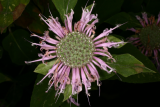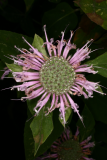Additional notes (click to expand)
Commemorative
The bee-balm and bergamot commemorates Nicolás Bautista Monardes (1512–88), physician
and botanist from Seville, son of an Italian bookseller and one of the most distinguished
physicians of his day (Guerra, 1961). He entered the University of Alcalá de Henares, where he obtained a degree in the arts in 1530 and his medical degree in 1533. He had his practice in Seville, at its University from 1547. While most biographers (Barnhart, 1965) give the year of his birth as 1493, this seems unlikely and 1512 is given in the catalogue of the Biblioteca Nacional de Lisboa (Lavoura, 2001) and by other bibliographic sources. It is to Monardes that we owe early information about medicinal plants from the New World, published in three parts (1569, 1571, 1574), the first one being Dos libros, el uno que trata de todas las cosas que se traen de nuestras Indias Occidentales, que sirven al uso de la Medicina, y el otra que trata de la Piedra Bezaar, y la Yerua Escuerçonera (two books, one which deals with all the things which come from West Indies, which are of use in medicine, and the other which deals with the bezoar stone and the herb called Escorzonera (Scorzonera hispánica or Scorzonera humilis)). The second book includes some of the
earliest information on tobacco; it was translated into English by John Frampton as Joyfull Newes out of the newe founde Worlde (1577).
Oakeley, Dr. Henry. (2012). Doctors in the Medicinal Garden. Plants named after physicians. Royal College of Physicians.
link
He describes tobacco being smoked by the Indians, but no English herbal in the next hundred years describes this usage. This new plant from Latin America was regarded as a wonderful panacea, and tobacco became known as Herba sancta – the holy plant – because of its supposedly curative virtues.Monardes was responsible for much of the enthusiasm for tobacco as a medicine. The sunflower appears here for the first time. Monardes also wrote a book expressing distrust of exotic drugs from the Americas, Diálogo llamado pharmacodilosis (1536), another on venesection in Greek and Arabic medicine, De secanda vena in pleuriti inter Grecos et Arabes concordia (1539), and about the medicinal properties of citrus fruits and roses, De rosa et partibus eius (1540).
Oakeley, Dr. Henry. (2012). Doctors in the Medicinal Garden. Plants named after physicians. Royal College of Physicians.
link
In 1537 he married Catalina Morales, the daughter of Garcia Perez Morales, professor of medicine at Seville. They had seven children. In addition to his medical practice he had a business in importing drugs and in the slave trade – which later bankrupted him. After his wife’s death in 1577 he became a cleric (Complete dictionary of scientific biography, 2008). He is reported to havedied from a cerebral haemorrhage. If this was at the age of 95 it would have been extraordinary at that era in history. However, an examination of the ages at which he graduated and published make it likely that he was born around 1512, as proposed in the Biblioteca Nacional de Lisboa catalogue, and died aged 76. His works were published in 42 editions and in six languages.
Oakeley, Dr. Henry. (2012). Doctors in the Medicinal Garden. Plants named after physicians. Royal College of Physicians.
link
Horticulture
Monarda didyma ‘Violet Queen’ and M. fistulosa in the family Lamiaceae are upright, hardy perennials which hail from North America. The brightly coloured flowers are popular with bees and butterfl ies when grown in a sunny border. They suffer in dry weather so we give them a good mulch of well-rotted manure in early spring and keep them well watered in summer.(Clare Beacham)
Oakeley, Dr. Henry. (2012). Doctors in the Medicinal Garden. Plants named after physicians. Royal College of Physicians.
link
Medicinal
The plant has a wide variety of medicinal
uses. The Ojibwe put a wad of chewed leaves of this
plant into their nostrils to relieve headache. The tops
of the plant were dried and used as a sternutatory for
the relief of colds. The leaves were placed in warm
water baths for babies. The Flambeau Ojibwe
gathered and dried the whole plant, boiling it in a
vessel to obtain the volatile oil to inhale to cure
catarrh and bronchial affections. The Menomini also
used this plant as a remedy for catarrh, steeping the
leaves and inflorescences in a tea. The Meskwaki
used this plant in combination with other plants to
relieve colds. The Hocak (Winnebago) used wild
bergamot in their sweat bath and inhaled the fumes to
cure colds. A decoction of boiled leaves was used as
a cure for eruptions on the face. The Cherokee made
a warm poultice of the plant to relieve a headache.
The Teton Dakota boiled together the leaves and
flowers as a cure for abdominal pains. The Blackfoot
made a tea from the blossoms and leaves to cure
stomach pains. They also applied boiled leaves to the
pustules of acne. The Tewa dried the plant and
ground it into a powder that was rubbed over the
head to cure headaches, over the body to cure fever,
and as a remedy for sore eyes and colds. Early white
settlers used it as a diaphoretic and carminative, and
occasionally employed it for the relief of flatulent
colic, nausea and vomiting
United States Department of Agriculture https://plants.usda.gov/DocumentLibrary/plantguide/pdf/pg_mofi.pdf
Monarda fistulosa L.
Family: LAMIACEAEGenus: Monarda
Species: fistulosa L.
Common names: American Wild Bergamot
Distribution summary: N. America
Habit: Perennial
Garden status: Not currently grown
Reason for growing: Commemorative, medicinal

.JPG)
.JPG)
.JPG)

.JPG)